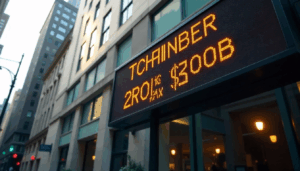Weakened Bitcoin Awaits Fed’s Decision, BofA Signals Quantitative Tightening’s Conclusion
Bitcoin Awaits Fed’s Move as Bank of America Foresees End of Quantitative Tightening
The potential conclusion of quantitative tightening (QT) could provide a boost to Bitcoin (BTC) and other risk assets, though economic uncertainty may temper gains.
As Bitcoin attempts to rebound from recent declines, all eyes are on Wednesday’s Federal Reserve (Fed) policy decision. Market participants are anticipating that an announcement signaling the end of the Fed’s balance sheet reduction program could serve as a positive catalyst.
The Fed’s rate decision will be released at 18:00 UTC, followed by Chairman Jerome Powell’s press conference half an hour later.
While no changes to the current interest rate range of 4.25% to 4.50% are expected, investors will focus on any updates regarding the QT program. The Fed must weigh liquidity management against Treasury market concerns and ongoing debt ceiling discussions. Additionally, the Fed’s summary of economic projections (SEP) will provide insights into policymakers’ economic outlook.
Since June 2022, the Fed has been systematically reducing its balance sheet, which expanded to $9 trillion in response to COVID-era stimulus measures. The QT program has been a key factor in tightening financial conditions and reversing the liquidity-driven boom that fueled the 2020-21 crypto rally. However, minutes from the Fed’s January meeting revealed discussions about slowing or pausing balance sheet reductions, suggesting Powell may address this possibility in today’s statement.
Noelle Acheson, author of the Crypto Is Macro Now newsletter, commented on the potential policy shift: “Fed Chair Powell previously hinted that QT could conclude in 2025. If he reaffirms this on Wednesday, it would signal a shift in monetary policy, paving the way for future interventions, should conditions warrant additional liquidity injections.”
Although full-scale quantitative easing (QE) is not expected in the near term, Acheson noted that an early QT exit would improve market liquidity by allowing the Fed to reinvest maturing securities. She also emphasized that such a move would help prevent liquidity disruptions in the Treasury market, which is facing $9 trillion in debt maturities this year.
Lauren Goodwin, economist at New York Life Investments, echoed this sentiment, suggesting that an early QT conclusion could act as a dovish signal that financial markets are eager to see.
On the decentralized prediction platform Polymarket, traders are fully pricing in a 100% probability that QT will end before May. The bet will resolve as “Yes” if the Fed increases its securities holdings by the end of April.
Bank of America Expects QT to End
Several leading investment banks, including Bank of America (BofA), believe the Fed is on the verge of pausing QT, citing economic uncertainty largely tied to President Donald Trump’s trade tariffs.
“Our rates strategists anticipate that the Fed will signal a QT pause until the debt ceiling situation is addressed, as suggested in the January meeting minutes. However, they do not foresee a resumption of QT afterward, with an official confirmation expected later this year,” BofA wrote in a March 14 client note.
A halt in QT could push yields on the 10-year U.S. Treasury note lower, reducing borrowing costs and making riskier assets like Bitcoin more attractive to investors.
Stagflation Fears Could Offset Gains
Trump’s tariffs have raised inflation risks while simultaneously threatening economic growth, setting the stage for stagflation. If the Fed’s economic projections reflect this reality, it could delay rate cuts, potentially limiting Bitcoin’s upside from a QT pause.
Acheson warned that a stagflationary adjustment—lower GDP forecasts paired with higher core PCE inflation estimates—could be reflected in the SEP, which may unsettle markets.
“If the Fed confirms a stagflationary shift in its outlook, markets may react negatively. Some of these risks are already priced in, but a definitive signal that rate cuts will be postponed could surprise those expecting near-term liquidity injections,” Acheson explained.
Recent U.S. retail sales data and regional manufacturing indices have indicated economic weakness, while forward-looking inflation measures have been climbing, likely in response to Trump’s trade policies.
Summing up the situation, Bank of America noted: “The latest economic data and enacted policies suggest the Fed will revise its growth forecast downward while raising its inflation expectations—indicating a subtle but important nod to stagflation.”
Despite these challenges, BofA still anticipates that the Fed’s dot plot will show two rate cuts in 2025 and 2026, underscoring the complex policy environment ahead.
Share this content:













